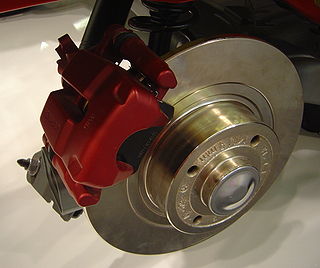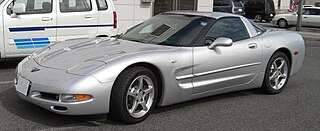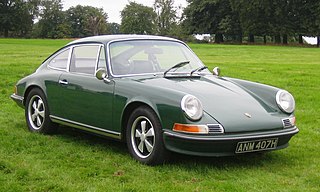
A disc brake is a type of brake that uses the calipers to squeeze pairs of pads against a disc or a rotor to create friction. There are two basic types of brake pad friction mechanisms: abrasive friction and adherent friction. This action slows the rotation of a shaft, such as a vehicle axle, either to reduce its rotational speed or to hold it stationary. The energy of motion is converted into heat, which must be dispersed.
In materials science, a metal matrix composite (MMC) is a composite material with fibers or particles dispersed in a metallic matrix, such as copper, aluminum, or steel. The secondary phase is typically a ceramic or another metal. They are typically classified according to the type of reinforcement: short discontinuous fibers (whiskers), continuous fibers, or particulates. There is some overlap between MMCs and cermets, with the latter typically consisting of less than 20% metal by volume. When at least three materials are present, it is called a hybrid composite. MMCs can have much higher strength-to-weight ratios, stiffness, and ductility than traditional materials, so they are often used in demanding applications. MMCs typically have lower thermal and electrical conductivity and poor resistance to radiation, limiting their use in the very harshest environments.

A compressed-air car is a compressed-air vehicle powered by pressure vessels filled with compressed air. It is propelled by the release and expansion of the air within a motor adapted to compressed air. The car might be powered solely by air, or combined with other fuels such as gasoline, diesel, or an electric plant with regenerative braking.

The Honda Insight is a hybrid electric vehicle that is manufactured and marketed by Honda. Its first generation was a two-door, two passenger liftback (1999–2006) and in its second generation was a four-door, five passenger liftback (2009–2014). In its third generation, it became a four-door sedan (2018–2022). It was Honda's first model with Integrated Motor Assist system and the most fuel efficient gasoline-powered car available in the U.S. without plug-in capability — for the length of its production run.

The Ford GT is a mid-engine two-seater sports car manufactured and marketed by American automobile manufacturer Ford for the 2005 model year in conjunction with the company's 2003 centenary. The second generation Ford GT became available for the 2017 model year.

A compressed-air vehicle (CAV) is a transport mechanism fueled by tanks of pressurized atmospheric gas and propelled by the release and expansion of the gas within a pneumatic motor.

The Shelby Mustang is a high-performance variant of the Ford Mustang built by Shelby American from 1965 to 1967 and by the Ford Motor Company from 1968 to 1970.

The Panhard Dyna Z is a lightweight motor car produced by Panhard of France from 1954 to 1959. It was first presented to the press at a Paris restaurant named Les Ambassadeurs on 17 June 1953 and entered production the following year. In 1959, it was replaced by the Panhard PL 17.
Hypermiling is driving or flying a vehicle with techniques that maximize fuel efficiency. Those who use these techniques are called "hypermilers". In the case of cars, this is an extreme form of energy-efficient driving.

The Chevrolet Corvette (C5) is the fifth generation of the Corvette sports car, produced by the Chevrolet division of General Motors for the 1997 through 2004 model years. Production variants include the high performance Z06. Racing variants include the C5-R, a 24 Hours of Daytona and 24 Hours of Le Mans GTS/GT1 winner. The C5 Corvette was the first GM vehicle to feature the third generation small block "LS" engines. Pop-up headlights were featured on a Corvette for the final time during this generation.

The Chevrolet Engineering Research Vehicle (CERV) is a series of Chevrolet experimental cars. Chevrolet Staff engineer, designer, and race car driver Zora Arkus-Duntov started development of the CERV I in 1959, and began work on the CERV II in 1963. Chevrolet chief engineer Don Runkle and Lotus' Tony Rudd discussed creating a new show car to demonstrate their engineering expertise in 1985; It would become the CERV III. Corvette chief engineer Dave Hill unveiled the CERV IV in 1993, a test vehicle for the 1997 C5 Corvette.
Hybrid vehicle drivetrains transmit power to the driving wheels for hybrid vehicles. A hybrid vehicle has multiple forms of motive power.

In the automotive industry, alloy wheels are wheels that are made from an alloy of aluminium or magnesium. Alloys are mixtures of a metal and other elements. They generally provide greater strength over pure metals, which are usually much softer and more ductile. Alloys of aluminium or magnesium are typically lighter for the same strength, provide better heat conduction, and often produce improved cosmetic appearance over steel wheels. Although steel, the most common material used in wheel production, is an alloy of iron and carbon, the term "alloy wheel" is usually reserved for wheels made from nonferrous alloys.

A vehicle frame, also historically known as its chassis, is the main supporting structure of a motor vehicle to which all other components are attached, comparable to the skeleton of an organism.

The seventh-generation Honda Civic is an automobile produced by Honda from 2000 until 2005. It debuted in September 2000 as a 2001 model. Its exterior dimensions stayed similar to the outgoing predecessor, with interior space significantly increased, bumping it up to the compact car size designation. A notable feature was the flat rear floor that gave better comfort to the rear seat passengers. This generation abandoned the front double wishbone suspension, used previously from fourth to sixth generations, replacing it with MacPherson struts. This generation was the last to offer 4WD variants.
Carbon fiber-reinforced polymers, carbon-fibre-reinforced polymers, carbon-fiber-reinforced plastics, carbon-fiber reinforced-thermoplastic, also known as carbon fiber, carbon composite, or just carbon, are extremely strong and light fiber-reinforced plastics that contain carbon fibers. CFRPs can be expensive to produce, but are commonly used wherever high strength-to-weight ratio and stiffness (rigidity) are required, such as aerospace, superstructures of ships, automotive, civil engineering, sports equipment, and an increasing number of consumer and technical applications.

The Mazda Kiyora is a concept car made by Mazda. It was first introduced at the 2008 Paris Motor Show. It is the next generation urban compact car intended to replace the Mazda2. It is a design study for next-generation compact car and also an engineering study of high fuel efficiency gasoline engine. The design theme of the Mazda Kiyora is water. It is applied to a city, a new trend in the automotive market due to environmental concerns. The Mazda Kiyora achieves 32 km/L of fuel efficiency and 90g/km of CO2 emission.

The McLaren 650S is a British sports car designed and manufactured by British automobile manufacturer McLaren Automotive. It was announced in February 2014 as a new model, but based on the existing MP4-12C with 25% new parts, and was formally unveiled at the 2014 Geneva Motor Show.
The Audi R8 LMS Cup was a one-make sports car racing series by Audi based in Asia. Audi R8 LMS Cup cars were based on the Audi R8 LMS (GT3).

The Fuchs wheel or Fuchsfelge is a specialty wheel made for the first Porsche 911 model in the early 1960s. Designed in conjunction with Otto Fuchs KG, Porsche modeler Heinrich Klie and Ferdinand Porsche Jr for the 1967 model year Porsche 911S, the Fuchs wheel was the first light-weight forged wheel to be fitted to a production automotive vehicle. They provided the rear-engined sports car with a reduction in unsprung mass, using a strong and lightweight alloy wheel.















